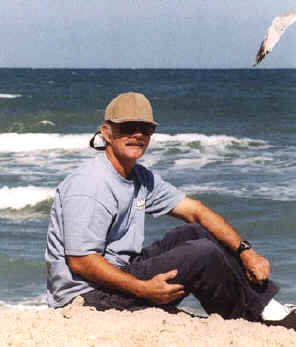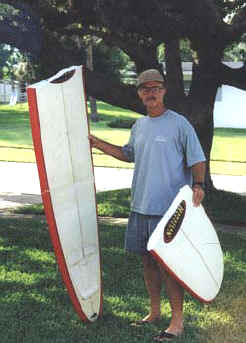Information about this Website Home Page
|| About this Site
|| Photo Galleries
|| Surf the Web Welcome! Thanks you for visiting our website. This website was created in 1997 as an alternative to maintaining synchronized lists of favorite surfing links on many different computers. For the first year or so, we averaged around 35 page views a day, mostly from ourselves. We now average around 7,500 page views per day, with up to 18,000 on days when good surf is inbound.
Surf conditions are extremely dynamic. It can be flat at 08:00 and be 6 feet by 10:00. It can be glassy one moment and wind-blown 20 minutes later. It can be un-rideable at one spot and just a few miles away be super fun. Surf forecasting is at best a form of fuzzy science. If full-time professional meteorologist can not tell you with greater than a 50 to 60 percent probability of success in which direction the wind will blow 24 hours from now, certainly part time surf forecasters are not going to be much more accurate. I review approximately 50 weather maps once or twice a day, observe local ocean conditions 1 to 3 times a day, and make my predictions based upon the information which I believe is most accurate. Sometimes I hit, sometimes I miss. That's life folks. Will there be surf in the next few days?I post a FORECAST of the anticipated surfing conditions for the next several days in the Cocoa Beach area (Port Canaveral to Melbourne Beach). Once in a while I'll also post a REPORT of what conditions are like out there. Of course, if it's good, I won't be near a computer until after dark. My goal is to provide a single "home page" with all the links needed to determine if a surf trip to the beach is worthwhile. These links consist of both surfing reports and weather data for the East Coast of Central Florida. Listed sites include live and frequently updated video camera views of popular surfing spots, visual reports of current surf conditions, weather and oceanographic data, graphical wind/wave action analysis models, and surfing forecasts by a few of us insane folks who examine all of this stuff every day. Today's Conditions Listed surfing report sites are those which are updated at least daily with visual reports of current surfing conditions. Some of these sites feature video camera views (CAMs) of the shoreline. Sites are ordered by geographical location - north to south. Some of these sites also feature multiple updates during the day as conditions change. If you would like a website added to the list, let me know (but it must have a daily surf report and provide value to my readers to be seriously considered). CFLsurf is also considered to be a "kid's safe" website. Thus, listed websites must also have content which our editorial staff considers appropriate for our audience. I don't attempt to link to all surf reports and webcam sites, only the best sites. Tomorrow's Predictions Listed sites include those that provide forecasts of future surfing conditions as well as sites which provide weather analysis data most frequently used to assist these predictions. Let's face reality folks... no one can predict with certainty what the surfing conditions will be like tomorrow, let alone three or four days from now. There are too many variables. However, an analysis of wind and storm data offers some pretty good clues about future surf conditions. The WAMs and Wave Watch III Key tools used to predict future surfing conditions include the Navy's Wave Action Models (WAMs) and NOAA Wave Watch III models. These models are viewed as easy to read color coded graphical presentations. Models are usually updated twice daily. Updates are at midnight (0000) and noon (1200) Greenwich Mean Time (GMT), which correspond respectively to 7:00 PM the day before and 7:00 AM the same day in Central Florida (i.e. - 0000 GMT on December 25th is 7:00 PM on December 24th here in Central Florida). These models are general in nature and need to be evaluated in consideration of wind speed and direction. Just because the model shows 6 to 9 foot waves bordering our coast, doesn't always mean we will have 6 to 9 foot surf. If the wind is blowing 35 knots from the NW, there may indeed be 9 foot waves a few miles off shore, but it could be almost flat south of Cape Canaveral. On the other hand, if the model shows a significant long-period swell (10 seconds or greater) off our coast, this is usually a good indication that we may get some good surf in the near future. The Wind In addition to the wave model, listed sites include marine forecasts and ocean buoy reports. Apart from ground swells, which usually originate from North Atlantic storms in the winter months and tropical storms in the summer months, a great deal of our surfable days result from wind-chop. Thus, you should repeat the following phrase until you thoroughly believe it: "I love wind-chop!". Also, this implies it's a good idea to watch the wind. If the wind blows our way hard enough and long enough, we will get waves. Wind speed of over 17 knots will generate some appreciable waves. Some of our best conditions occur when a strong onshore blow is followed by a wind shift to offshore or light wind conditions. In such cases you have to get on it quick, since wind-chop surf dies quickly. It's a good idea to check the marine forecasts daily. The Buoys The buoys are a surfer's best friend. Buoy 41009 (20 miles east of Cape Canaveral and thus called "the 20 mile buoy") and buoy 41010 (120 miles east of Cape Canaveral) provide insight to both wind and swell. The 20 mile buoy gives you an indication of near current conditions, and the 120 mile buoy gives you an indication as to what we could be getting 5 or 6 hours from now. Although the buoys don't tell you which way a swell is heading (and a swell can move counter to the wind), if there is a sizable long period swell, you can bet your lunch money it's heading our way. As a general rule of thumb, if winds are light or offshore, a swell of 2.6 feet or greater at a period of 10 seconds or greater begins to give us rideable fun. On the other hand, if the wind is howling onshore and the wave period is short (9 seconds or less), we need waves around 5 feet or more at the 20 mile buoy to give us rideable fun. Wind and Wave Data Links to both the Navy's Fleet Numerical Analysis (FNMOC) wave data and NOAA wave data are provided. The NOAA Wave Watch III data provides better resolution for us than the Navy's WAMs. If you haven't visited the Wave Watch III site, plan on spending a few minutes learning how to use it. In addition, it never hurts to look at more than one view of analysis data. Not all this information is as "user friendly" as the WAMS, but gives us some good insight into the waves of the future. Wind vs Wave Effects The following table shows the wave sizes generated by different wind speeds when the wind blows for a long time in the same direction. The term knot stands for "nautical miles per hour" and is equivalent to about 1.15 mph. As you can see, when the wind goes above 17 knots, we start to get some serious surf.
Cool hat ($22), Davo tee shirt ($15), baggy dockers ($32), nerdy socks ($3), blue Vans ($65) ( Due to the large number of orders I have received for the socks, please be advised that the above ad is ment to be a joke.)
We also serve longboards by the slice!
|

